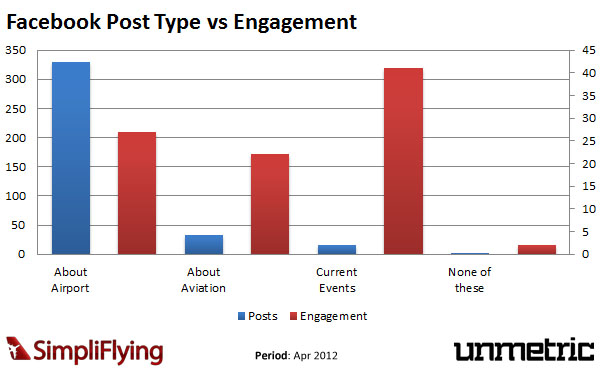Editor’s Note: Here’s another guest post by Peter Claridge of Unmetric, an exclusive aviation partner of SimpliFlying. Unmetric is a social media benchmarking company that helps brands analyse how well they’re doing on social media by including in-depth insights into numerous metrics as well as information on what kind of content “works” and how competitors are faring. Among Unmetric’s list of illustrious clients are Citibank, Nestlé and AirTel.
Life must be tough for the various airport communication teams around the world. Tens of millions of passengers have to navigate all kinds of procedures and queues followed by the labyrinths of gates, levels and departure lounges that many modern airports now have. Travellers taking connecting flights have to take shuttles to different terminals, sometimes having to go through security again or even immigration; there is just no end to the number of ways things can go wrong or travellers can get confused.
As Sascha Segan of Frommers put it, some airports can be “at best joyless econoboxes, at worst purgatorial warehouses of stalled lives” which I think has to be one of the most beautifully negative phrases I’ve ever read.

In the past, you could easily identify the travellers who had problems from the long, snaking queue next to the help desk – that is, if they were even able to find the help desk. The most obvious problem with this is that even for small questions, the traveller had to wait patiently in line – taking them away from the more important job of deciding what whiskey to buy or hurriedly picking up a random gift for the significant other. Although no amount of free time would ever convince me to buy a lottery ticket to win the Ferrari or Porsche.
The other, less obvious problem is that the longer the person has to wait in line to get their questions answered, the more frustrated they become and the greater the negative perception would be of the airport. According to one BBC article, “for every 10 minutes people have to wait, a disproportionate amount of time would have to be spent encouraging them it is a great place to do business or go on holiday”. Since most Western airports are now privately operated, negative perceptions take on a more critical role because they can hurt profits!
Step in Facebook and Twitter
For some travellers, they can now get a quick response to their questions without having to wait on hold to a helpline or standing inline to speak to the helpdesk. The well connected traveller can tap out their problem on Twitter using their smartphone and still have time to pick up the double latte and Danish pastry breakfast from the departure lounge Starbucks.

Virtually all major airports have embraced Facebook as a way of engaging travellers and building their brand perception. The exceptions, of course, are airports in China where Facebook is banned. The extent to which airports have gone to promote social media as a primary communication tool does vary from airport to airport as the graph below shows.
There doesn’t seem to be any correlation whatsoever in terms of passenger numbers of the number of Facebook fans and Twitter followers the various airports have. Heathrow leads the field when it comes to number of Twitter followers while Amsterdam Schiphol has done a fantastic job of building up its Facebook fanbase.
Of the top ten airports by passenger numbers that had Facebook pages, only eight of them also operated official Twitter accounts. Maintaining a Facebook presence appears to be much more important to airports than being on Twitter. Infact, of the 150 major airports around the world that we looked at that have Facebook pages, only 86 maintain Twitter accounts.
Massive Growth in 2012
With the exception of Hong Kong (which probably has its own reasons), all the airports are seeing huge growth rates for both Facebook and Twitter. The Facebook accounts for airports have grown by an average of nearly 80% in the last four months, while Twitter accounts have swelled by 40%. Leading the field for Facebook growth is Heathrow, having tripled the number of fans in just four months. Chicago O’Hare airport is seeing phenomenal Twitter growth, but only because it has fewer than 1,000 followers.
Part of the reason Heathrow has seen such a huge increase could be down to the amount of industrial action that has taken place in 2012 with cabin crew, public transport employees and immigration officers all going strike. The Heathrow Facebook page has been a key source of information for travellers who might be affected by the strikes coupled with the promotion the airport is doing for the 2012 Olympics.
What Are The Airports Talking About
Like most brands, airports tend to have quite a narcissistic streak, preferring to talk about themselves, or at a push, the aviation industry. Unmetric manually reviews and categorizes every post made by brands in our database and the chart below shows that when a brand talks about current events, engagement is a lot higher. For example, holidays drive huge amounts of engagement and gives the airport the opportunity to ask where people are off to.
The graph below shows the top level content categorization for all the posts made by the airports we have analysed.
How Quickly Are Airports Responding
Airports are able to make the experience they provide for travellers that much better if they are able to resolve any problems that may arise. Twitter has turned out to be the perfect platform for airlines to seek out and respond to problems that customers are having and similarly, many airports have realized that in order to provide a fantastic experience, they need to seek out and help people who are posting on Twitter.
The graph below shows the number of queries an airport responded to in the first four months of the year and the average amount of time it took for them to reply. Frankfurt Airport is far ahead of every other airport in the world, responding to nearly 4,500 tweets in an average of 90 minutes. This is exceptional for the airports, but pales in comparison to the airline industry where some carriers are responding to tweets in around 10 minutes.
When are Airports Tweeting
One the reasons Frankfurt are replying to so many people so quickly is that they have a 24 hour operation on Twitter. However, the (timezone adjusted) chart below shows that most airports prefer to stick with a regular 9-5 shift. This does make us wonder what travellers are supposed to do for the 14 hours when no one is listening. Worse, are airports that leave travellers high and dry over the weekend, ones where no one is monitoring their Twitter account?
If an airport is going to take the decision to provide a support channel and to reach out to people via Twitter then they need to have a strategy in place where there are staff available to quickly answer questions at peak times (preferably in less than 20 minutes). If the airport has planes departing and arriving 24 hours a day (as most airports do nowadays) then the Twitter operation needs to be a 24 hour operation.
So Who Is Doing The Best Job?
Comparing so many metrics can muddy the water a bit to determine which airport is doing the best job on social media. We use the Unmetric score, a combination of 24 quantitative and qualitative measurements blended together to give a single score. Airports have one score for Facebook and one for Twitter. The chart below shows just how well the European airports are doing compared to their American counterparts.
It’s clear that most airports are doing a good job of social media and some, like Frankfurt and Amsterdam are even doing exceptional jobs. There is still scope for improvement though, in this respect the airlines that serve these airports are leading the way with their social media. By reducing the average response time on Twitter and posting more engaging content on Facebook, airports can turn disgruntled travellers in to happy ones, or at least contented ones. Often there isn’t much that an airport can do about the security or immigration queues, but by keeping people informed it helps reduce negative perceptions and makes the airport a pleasurable place to be.
Find out more about how Unmetric can help your airline benchmark its social media prowess here. Or drop us a line directly at unmetric@simpliflying.com.
You can see previous posts by Unmetric here.







